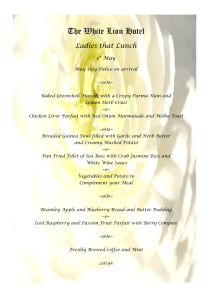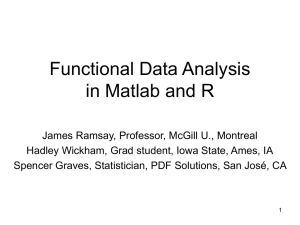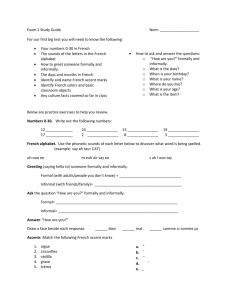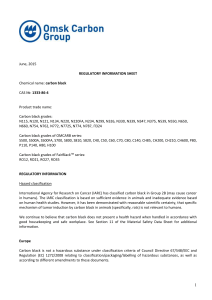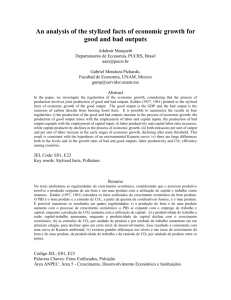Experiments vs. comparative observational studies
advertisement
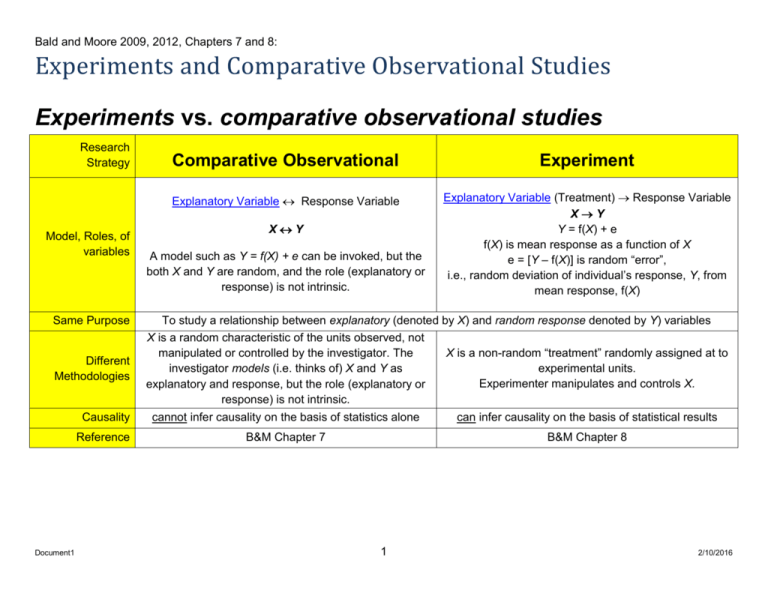
Bald and Moore 2009, 2012, Chapters 7 and 8: Experiments and Comparative Observational Studies Experiments vs. comparative observational studies Research Strategy Model, Roles, of variables Same Purpose Different Methodologies Document1 Comparative Observational Experiment Explanatory Variable Response Variable Explanatory Variable (Treatment) Response Variable XY Y = f(X) + e f(X) is mean response as a function of X e = [Y – f(X)] is random “error”, i.e., random deviation of individual’s response, Y, from mean response, f(X) XY A model such as Y = f(X) + e can be invoked, but the both X and Y are random, and the role (explanatory or response) is not intrinsic. To study a relationship between explanatory (denoted by X) and random response denoted by Y) variables X is a random characteristic of the units observed, not X is a non-random “treatment” randomly assigned at to manipulated or controlled by the investigator. The investigator models (i.e. thinks of) X and Y as experimental units. Experimenter manipulates and controls X. explanatory and response, but the role (explanatory or response) is not intrinsic. Causality cannot infer causality on the basis of statistics alone can infer causality on the basis of statistical results Reference B&M Chapter 7 B&M Chapter 8 1 2/10/2016 Can have more than one explanatory variable Y = f(X1) + e Y = f(X1, X2) + e Y = f(X1, X2, X3) + e There may be “lurking” explanatory variables that are were not included in the study. Why observe rather than experiment? 1. Unethical or impossible to assign units to certain treatments, e.g., cigarette smoking studies 2. Certain explanatory variables are inherent traits, e.g., sex, gender 3. Ecological Validity, e.g., Jane Goodall, Diane Fossey Design of Experiments, Terminology (from B&M Chapter 8) The individuals studied in an experiment are often called subjects, particularly when they are people. The explanatory variables in an experiment are often called factors (B&M, Section 8.1). A treatment is any specific experimental condition applied to the subjects. If an experiment has several factors, a treatment is a combination of specific values of each factor (B&M, Section 8.1). An experimental group is a group of individuals receiving a treatment whose effect we seek to understand (B&M, Section 8.2). A control is a treatment meant to serve as a baseline to which the experimental group is compared (B&M, Section 8.2). A placebo is a control treatment that is fake (for example, taking a sugar pill) but otherwise indistinguishable from the treatment in the experimental group (B&M, Section 8.2). Document1 2 2/10/2016 Terms used in design of experiments experimental unit smallest basic objects to which we can assign and apply different treatments observational unit objects or individuals measured in any study Note: experimental unit and observational unit can be different objects in the same study. The sample size is the number of experimental units, not the number of observational units. Example 1: Effect of diet (high protein, high fat, high carbohydrate) on weight gain (kg) of pigs A total of 48 pigs are raised in 6 pens, with 8 pigs per pen. In each pen, pigs eat from a common trough. Two (2) pens are randomly assigned to each diet (high protein, high fat, high carbohydrate). Each pig’s weight gain (kg) is measured at after 10 days on the diet. Variable Type Diet (hi pro, hi fat, hi carb) qualitative Wt gain (kg) Role explanatory quantitative response 1. experimental unit is (multiple choice) a. the pig, because each pig is weighed b. the pen (Not the pig), because pigs are fed from one trough in each pen 2. observational unit is (multiple choice) a. the pig, because each pig is weighed b. the pen (Not the pig), because pigs are fed from one trough in each pen Document1 3 Pen 1 OOOO protein OOOO Pen 2 OOOO carb OOOO Pen 3 OOOO protein OOOO Pen 4 OOOO fat OOOO Pen 5 OOOO carb OOOO Pen 6 OOOO fat OOOO 2/10/2016 Example 2: Effect of diet (high protein, high fat, high carbohydrate) on wt gain (kg) of middle-school boys A total of 36 boys are fed in 6 schools, with 6 boys per school. In each school, children eat in a common cafeteria. Two (2) boys in each school are randomly assigned to each diet (high protein, high fat, high carbohydrate). Each boy’s weight gain (kg) is measured at after 10 days on the diet. 3. experimental unit is (multiple choice) a. the boy b. the school 4. observational unit is (multiple choice) a. the boy b. the school Document1 4 School 1 OOO OOO School 2 OOO OOO School 3 OOO OOO School 4 OOO OOO School 5 OOO OOO School 6 OOO OOO 2/10/2016 Random Assignment of Treatments to Experimental Units (or vice versa) Randomized comparative experiments are designed to give good evidence that differences in the treatments actually cause the differences we see in the response. The logic is as follows (B&M Section 8.2: Random assignment of subjects forms groups that should be similar in all respects before the treatments are applied. B&M Exercise 8.51 uses the Simple Random Sample applet to demonstrate this. Comparative design ensures that influences other than the experimental treatments (i.e., lurking explanatory variables) operate equally on all groups. Therefore, differences in average response must be due either to the treatments or to the play of chance in the random assignment of subjects to the treatments. Document1 5 2/10/2016 Design Restricted Randomization (blocking, repeated measures, before and after, matched pairs, matched k-tuples) Completely Randomized Design (CRD) In a completely randomized experimental design, all the experimental units are allocated at random Definition among all the treatments, such that each experimental unit has an equal chance of receiving each treatment. More randomization makes it less likely that influences Why? other than the experimental treatments. I.e., lurking variables are less likely to be confounded with treatments. Reference Under restricted randomization, experimental units are subdivided into homogeneous “blocks”, such that all the units are as similar as possible in each block, with an equal number (often 1) of experimental unit for each treatment in each block. I.e., number of units per block is an integer multiple (often 1) of the number of treatments. Treatments are assigned randomly to the experimental units within each block. When there is a great deal of variation (noise) among experimental units, restricted randomization will eliminate the uncertainty and potential confounding due to that lack of homogeneity. School 1 School 2 School 3 School 1 School 2 School 3 OOO OOO OOO OOO OOO OOO OOO OOO OOO OOO OOO OOO School 4 School 5 School 6 School 4 School 5 School 6 OOO OOO OOO OOO OOO OOO OOO OOO OOO OOO OOO OOO B&M Section 8.2 B&M Section 8.3 Continued in Restricted Randomization Document1 6 2/10/2016
